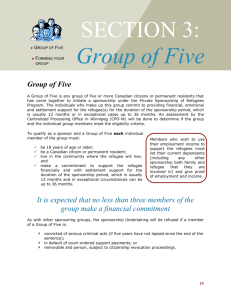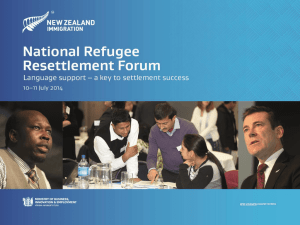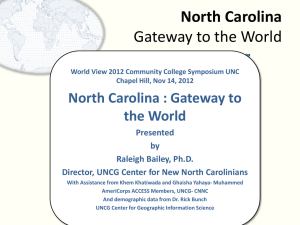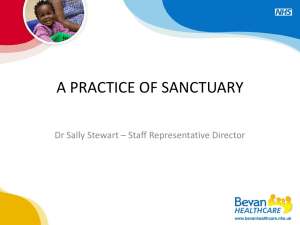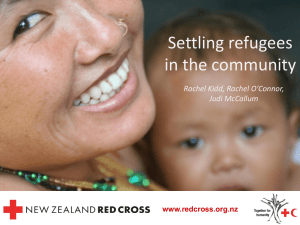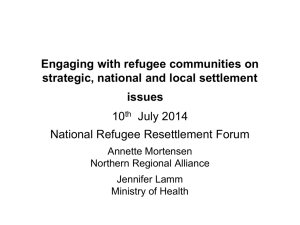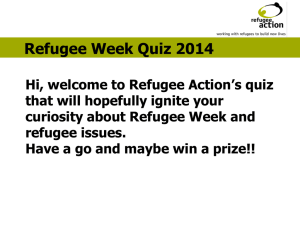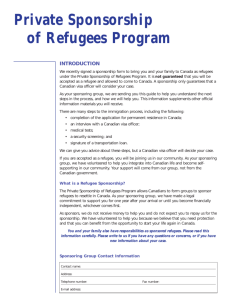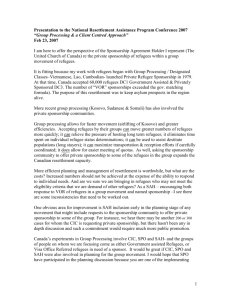Migration–Net - Immigration and Social Integration
advertisement
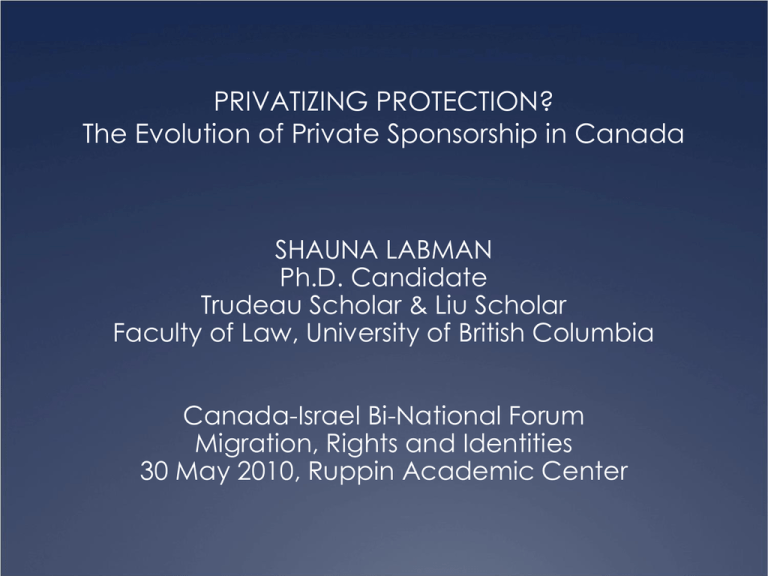
PRIVATIZING PROTECTION? The Evolution of Private Sponsorship in Canada SHAUNA LABMAN Ph.D. Candidate Trudeau Scholar & Liu Scholar Faculty of Law, University of British Columbia Canada-Israel Bi-National Forum Migration, Rights and Identities 30 May 2010, Ruppin Academic Center Canadian Background 4 June 1969: Canada ratified 1951 Convention & 1967 Protocol Immigration Act, 1976: 1st Canadian legislation to put refugee policy in statutory form Act contemplated both non-refoulement and resettlement Both government resettlement and private sponsorship included Immigration and Refugee Protection Act, 2001 Bill C-11: Balanced Refugee Reform Act, 2010 History of Private Sponsorship Pre-1976 informal private assistance from religious organizations Canadian Christian Council for the Resettlement of Refugees, 1946 Lobbying for legislation predominantly from ethnic groups wanting to resettle refugees from the Soviet Union and Eastern Europe Indochinese “boat-people” crisis merged with introduction of private sponsorship scheme Private Sponsorship Structure Outset: “Group of Five” or “Master Agreement” Now: “Group of Five”; “Community Sponsor”; “Constituent Groups” (CGs) CGs are members of “Sponsorship Agreement Holder” (SAH) organization ~ 85% of sponsors are CGs/SAHs. 87 SAHs as of 2007 Co-Sponsorship Joint Assistance Program Benefits of Private Sponsorship Increases resettlement numbers Voice and power to private citizens Creates refugee advocacy community Direct contact between refugees and community Government indicator of support Tensions 1. Shifting of Responsibility state -> private 2. Public Perceptions Canadian receptiveness resettlement vs. asylum genuine vs. false refugees 3. Selection Known vs. UNHCR refugees Shifting Responsibility Complementary objective But: Sponsor concern of bearing burden Processing prioritizations Gov’t taking credit Future Promises 2009 CIC Annual Report: doubling of privately sponsored Iraqi refugees accepted over 5 yrs 2010 Press Release: 2,000 inc in Priv Spon #s Sustainability? “It remains to be seen whether the resource is renewable, like forests, or whether it more closely resembles gold and, once again mined, is depleted” Public Perceptions 1986: Canada awarded the Nansen Medal 1987: 7,437 1989: 21,631 (peak) 1989: 31% of Canadians felt that too many refugees were admitted in 1989 by 1991 number jumped to 49% Genuine vs. false refugees Resettlement vs. asylum Selection Sponsor-referred (require approval) ~ 90-95% family/friends ~49% refusal rate (1998-2007) Or Visa office-referred (CIC approved) Less than 2% of PS (2002-2005) Consequences of Sponsor-Referrals Sustainable sponsorship (social capital) vs. continued need Program global & flexible vs. regional gaps/ non-UNHCR refugees / high refusal rate Refusal rate: drains resources / blurs protection vs. better connected/informed than gov’t Meeting in the Middle JAS: non-financial sponsorship Blended projects: ethnic support & protection need Project FOCUS Afghanistan Special 3/9 Sponsorship Pilot Program Anglican Primate 50 Refugee Families Sponsorship Project Population building strategy Winnipeg Private Refugee Assistance Program תודה
